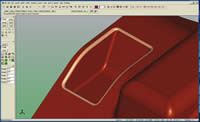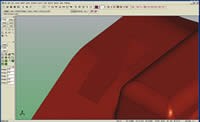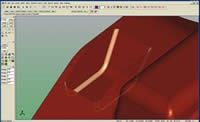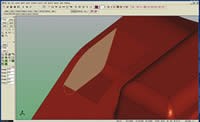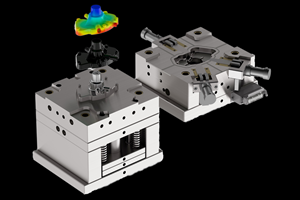The Value of Direct Data Manipulation Capabilities
How modern manufacturing pressures are driving moldmakers to look for new ways to easily access and manipulate product data.
Recent market shifts are forcing design and manufacturing companies to focus anew on value-added services like determining the manufacturability of designs in order to increase productivity and decrease time-to-market. In particular, global competition is heating up and the offshore outsourcing of manufacturing is placing heightened pressure on small job shops and fabricators. For example, in addition to its traditional low-cost business model and cheap labor, China is now able to offer higher quality products and support for more complex manufacturing processes. These improvements have allowed China to expand beyond the mass manufacturing of simple products that was its trademark a mere five years ago.
Global competition, combined with consolidation among U.S.-based mold shops, creating heterogeneous CAD environments, are heaping on added pressures. As a result, moldmakers—often smaller and less resource-rich organizations—are required to accept custo-mer design information in a wide range of proprietary formats or lose the business—business they can ill-afford to walk away from.
In many instances, design files arrive at the mold shop with flaws in the design. These imperfections, if not addressed, result in flawed end products as well as in slower bidding cycles, both of which impact revenue. However, simply working with parametric modeling tools will not provide the desired level of editing flexibility. In the case of parametric modeling tools, often users are unable to change models without editing the geometry locally by, using face editing tools.
By virtue of their size, most job shops cannot afford to own, support and maintain the in-house expertise necessary to use the numerous, disparate CAD tools in use in the industry today. While there are other options to actually owning all the different tools on the market, these options typically come at a price well outside the reach of most small businesses.
And, it isn’t just the different file formats. Proprietary 3-D para-metric modeling constructs inside the diverse CAD data formats can pose significant obstacles too. Imported designs are difficult and, in some cases impossible, to modify. Simply importing a CAD file to a different format will not guarantee that all the information needed to complete a job will remain intact. The design intent put into the CAD file may not be the intent required by the manufacturing engineer or moldmaker. The complexities of this data translation, whether it is between varying CAD programs or file formats, has an obvious detrimental impact and can lead to lag times in the bidding process and slower time-to-market. In either instance, business suffers and revenue can be lost to the competition, whether that competition is across the sea or down the street.
Mold shops need to ensure that they have direct data manipulation capabilities. All too often product designers create items that manufacturers cannot possibly fabricate—be that because the part is simply impossible to mold, they don’t have equipment available for a specified procedure or tolerances, and clearances are insufficient. It is for these reasons that smaller shops must have access to and utilize tools that can perform double duty. What is needed are truly interoperable products.
Direct Feature Editing
The ability to rapidly and accurately work with multiple file types and CAD formats is crucial to the survival of smaller independent moldmakers and design firms. Companies must have direct access to product geometry—whether it is a 3-D surface, solid model or a simple 2-D design. One method for achieving the delicate balance of agility and multipurpose accuracy is through the implementation of design tools with direct feature editing capabilities. Direct feature editing allows for the geometry itself of a design to be modified as features—which is more effective than so-called direct editing, which only allows for the manipulation of faces at a very low level.
Designers and manufacturers alike need direct feature editing capabilities. Technologies that provide direct modeling and editing allow designers and manufacturers to work outside the feature tree or a history tree. This allows them to leverage previous design form feature constructs with ease. Direct feature editing dynamically recognizes features without specific feature information and allows edits and modifications without the feature tree. Additionally, direct featuring editing frees the end user from being wed to solid history trees, constraints or feature recording, and in so doing allows them to understand the intent of a design and easily make adjustments and edits.
The need for direct feature editing is not isolated to small mold shops that take in designs and bring them through the manufacturing process. It also impacts larger companies with both design and manufacturing divisions. In both cases, the ability to utilize creative tools that allow for the manipulation of product geometry at an explicit level is of the utmost importance.
Related Content
Four Micro Tooling Considerations
Issues involving gating, ejection, mold splits and direction of pull are of special concern when it comes to micro tooling.
Read MoreHow to Analyze and Optimize Cutting Conditions to Reduce Cycle Time
Plastic injection mold design and manufacturing company puts NC program optimization software module to the test. The results were surprising.
Read MoreTips for Tackling Mold Design, Machining, Cutting Tool and Wear Challenges
Tips for tasks ranging from reducing risk in part design and taking advantage of five-axis machining to refining cutting tool performance and reducing wear with guiding and centering systems.
Read MoreBest Practices for Hitting Critical Numbers: Communication and the Shrinkage Factor
Start with an upfront review, discussion and collaboration with the customer and then consider the shrinkage factor.
Read MoreRead Next
Overcoming Pain Points in Moldmaking with AI
Shops that embrace AI as a tool, not a threat, can enhance efficiency, preserve expertise, and attract tech-savvy talent.
Read MoreHow to Use Continuing Education to Remain Competitive in Moldmaking
Continued training helps moldmakers make tooling decisions and properly use the latest cutting tool to efficiently machine high-quality molds.
Read More


